UGB 335: Strategic Marketing Analysis of BYD Energy's Challenges
VerifiedAdded on 2021/05/07
|20
|4884
|274
Report
AI Summary
This report provides a strategic marketing analysis of BYD Energy, a tech-based company focused on zero-emission energy solutions. It examines BYD's mission, vision, competencies, and growth strategies using the Ansoff matrix, revealing its focus on product development, market development, and differentiation. The BCG matrix highlights the increasing market and share of renewable batteries. The report also analyzes the marketing mix and identifies areas for strategic improvement. Furthermore, it explores BYD's innovation and social/ethical strategies, including its CSR activities and ethical corporate governance. A critical competitive analysis compares BYD with Tesla and GCL System Integration Technology, considering their strategies, competencies, and market positioning. The report concludes with a summary of BYD's competitive advantages and challenges within the dynamic energy market.

analysis of strategic marketing context and critical evaluation of challenges to
successful strategic marketing
BYD Energy
UGB 335 Strategic Marketing
successful strategic marketing
BYD Energy
UGB 335 Strategic Marketing
Paraphrase This Document
Need a fresh take? Get an instant paraphrase of this document with our AI Paraphraser
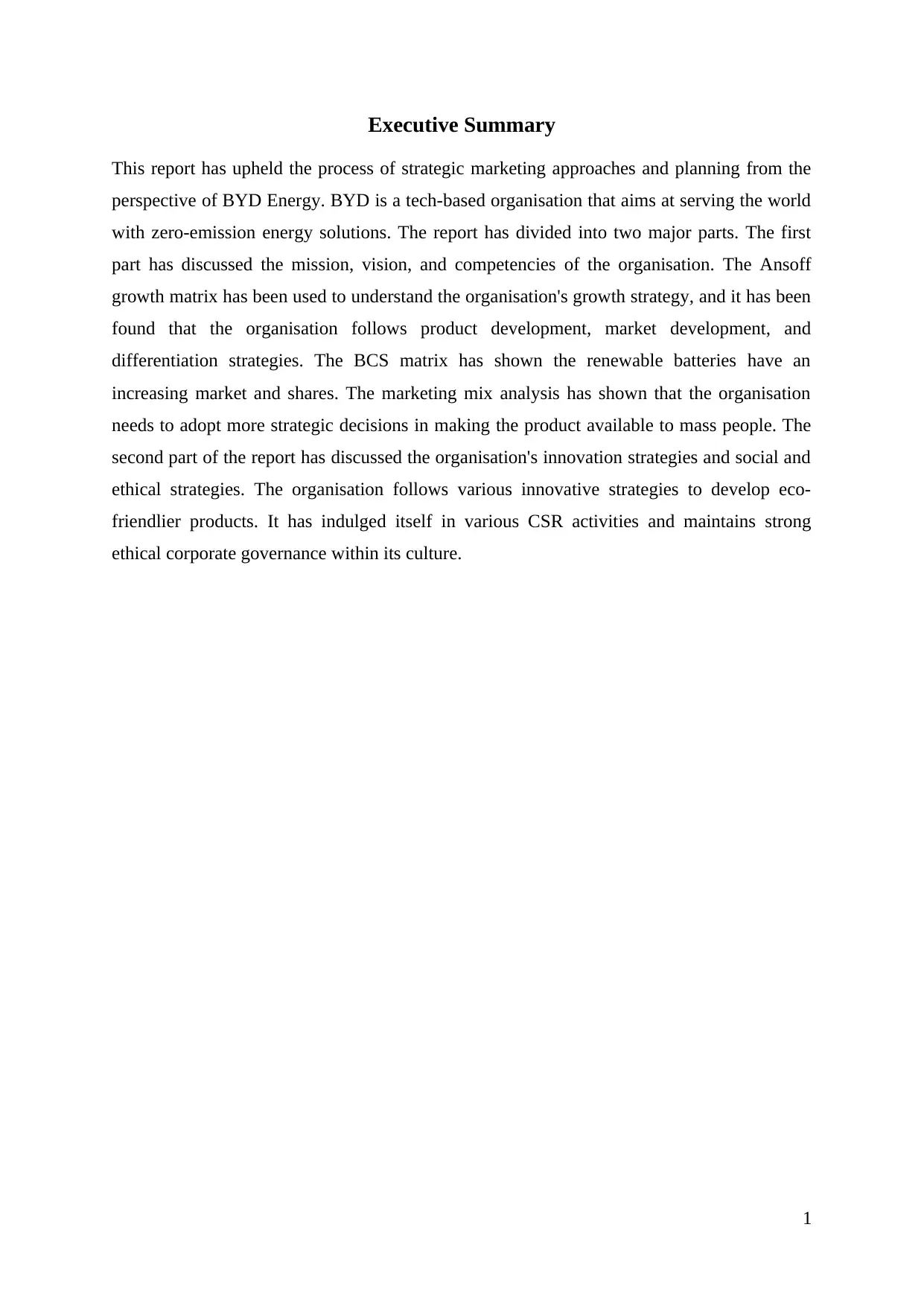
Executive Summary
This report has upheld the process of strategic marketing approaches and planning from the
perspective of BYD Energy. BYD is a tech-based organisation that aims at serving the world
with zero-emission energy solutions. The report has divided into two major parts. The first
part has discussed the mission, vision, and competencies of the organisation. The Ansoff
growth matrix has been used to understand the organisation's growth strategy, and it has been
found that the organisation follows product development, market development, and
differentiation strategies. The BCS matrix has shown the renewable batteries have an
increasing market and shares. The marketing mix analysis has shown that the organisation
needs to adopt more strategic decisions in making the product available to mass people. The
second part of the report has discussed the organisation's innovation strategies and social and
ethical strategies. The organisation follows various innovative strategies to develop eco-
friendlier products. It has indulged itself in various CSR activities and maintains strong
ethical corporate governance within its culture.
1
This report has upheld the process of strategic marketing approaches and planning from the
perspective of BYD Energy. BYD is a tech-based organisation that aims at serving the world
with zero-emission energy solutions. The report has divided into two major parts. The first
part has discussed the mission, vision, and competencies of the organisation. The Ansoff
growth matrix has been used to understand the organisation's growth strategy, and it has been
found that the organisation follows product development, market development, and
differentiation strategies. The BCS matrix has shown the renewable batteries have an
increasing market and shares. The marketing mix analysis has shown that the organisation
needs to adopt more strategic decisions in making the product available to mass people. The
second part of the report has discussed the organisation's innovation strategies and social and
ethical strategies. The organisation follows various innovative strategies to develop eco-
friendlier products. It has indulged itself in various CSR activities and maintains strong
ethical corporate governance within its culture.
1

Table of Contents
Introduction................................................................................................................................3
About BYD Energy....................................................................................................................3
Analysis of strategic marketing context and critical evaluation of challenges to successful
strategic marketing.....................................................................................................................4
Critical company analysis......................................................................................................4
Critical competitive analysis..................................................................................................7
Customer analysis................................................................................................................10
Examination of two key topics.................................................................................................11
Innovation strategies............................................................................................................12
Social and Ethical Strategies................................................................................................13
Conclusion................................................................................................................................15
References................................................................................................................................16
Appendices...............................................................................................................................18
2
Introduction................................................................................................................................3
About BYD Energy....................................................................................................................3
Analysis of strategic marketing context and critical evaluation of challenges to successful
strategic marketing.....................................................................................................................4
Critical company analysis......................................................................................................4
Critical competitive analysis..................................................................................................7
Customer analysis................................................................................................................10
Examination of two key topics.................................................................................................11
Innovation strategies............................................................................................................12
Social and Ethical Strategies................................................................................................13
Conclusion................................................................................................................................15
References................................................................................................................................16
Appendices...............................................................................................................................18
2
⊘ This is a preview!⊘
Do you want full access?
Subscribe today to unlock all pages.

Trusted by 1+ million students worldwide
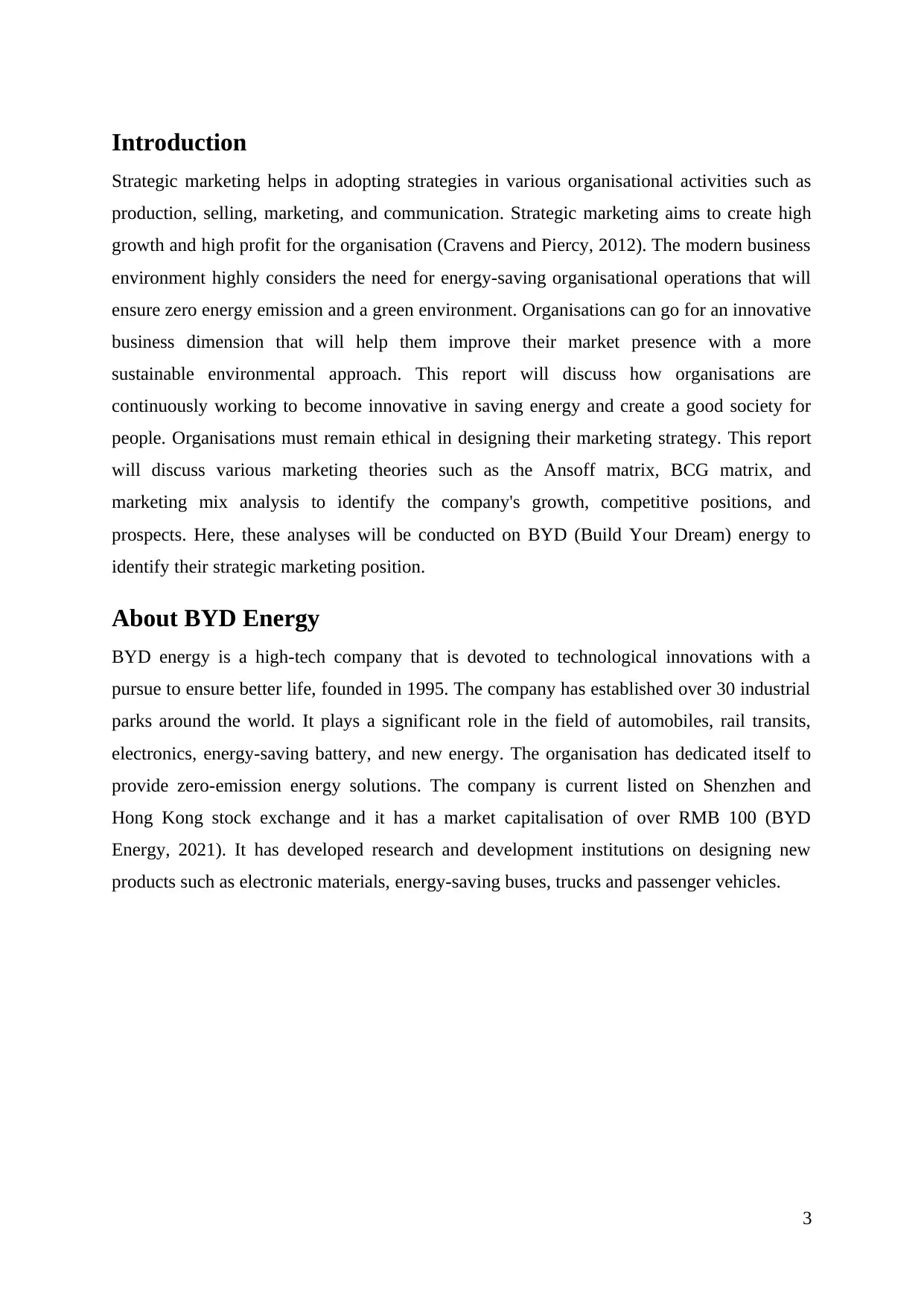
Introduction
Strategic marketing helps in adopting strategies in various organisational activities such as
production, selling, marketing, and communication. Strategic marketing aims to create high
growth and high profit for the organisation (Cravens and Piercy, 2012). The modern business
environment highly considers the need for energy-saving organisational operations that will
ensure zero energy emission and a green environment. Organisations can go for an innovative
business dimension that will help them improve their market presence with a more
sustainable environmental approach. This report will discuss how organisations are
continuously working to become innovative in saving energy and create a good society for
people. Organisations must remain ethical in designing their marketing strategy. This report
will discuss various marketing theories such as the Ansoff matrix, BCG matrix, and
marketing mix analysis to identify the company's growth, competitive positions, and
prospects. Here, these analyses will be conducted on BYD (Build Your Dream) energy to
identify their strategic marketing position.
About BYD Energy
BYD energy is a high-tech company that is devoted to technological innovations with a
pursue to ensure better life, founded in 1995. The company has established over 30 industrial
parks around the world. It plays a significant role in the field of automobiles, rail transits,
electronics, energy-saving battery, and new energy. The organisation has dedicated itself to
provide zero-emission energy solutions. The company is current listed on Shenzhen and
Hong Kong stock exchange and it has a market capitalisation of over RMB 100 (BYD
Energy, 2021). It has developed research and development institutions on designing new
products such as electronic materials, energy-saving buses, trucks and passenger vehicles.
3
Strategic marketing helps in adopting strategies in various organisational activities such as
production, selling, marketing, and communication. Strategic marketing aims to create high
growth and high profit for the organisation (Cravens and Piercy, 2012). The modern business
environment highly considers the need for energy-saving organisational operations that will
ensure zero energy emission and a green environment. Organisations can go for an innovative
business dimension that will help them improve their market presence with a more
sustainable environmental approach. This report will discuss how organisations are
continuously working to become innovative in saving energy and create a good society for
people. Organisations must remain ethical in designing their marketing strategy. This report
will discuss various marketing theories such as the Ansoff matrix, BCG matrix, and
marketing mix analysis to identify the company's growth, competitive positions, and
prospects. Here, these analyses will be conducted on BYD (Build Your Dream) energy to
identify their strategic marketing position.
About BYD Energy
BYD energy is a high-tech company that is devoted to technological innovations with a
pursue to ensure better life, founded in 1995. The company has established over 30 industrial
parks around the world. It plays a significant role in the field of automobiles, rail transits,
electronics, energy-saving battery, and new energy. The organisation has dedicated itself to
provide zero-emission energy solutions. The company is current listed on Shenzhen and
Hong Kong stock exchange and it has a market capitalisation of over RMB 100 (BYD
Energy, 2021). It has developed research and development institutions on designing new
products such as electronic materials, energy-saving buses, trucks and passenger vehicles.
3
Paraphrase This Document
Need a fresh take? Get an instant paraphrase of this document with our AI Paraphraser
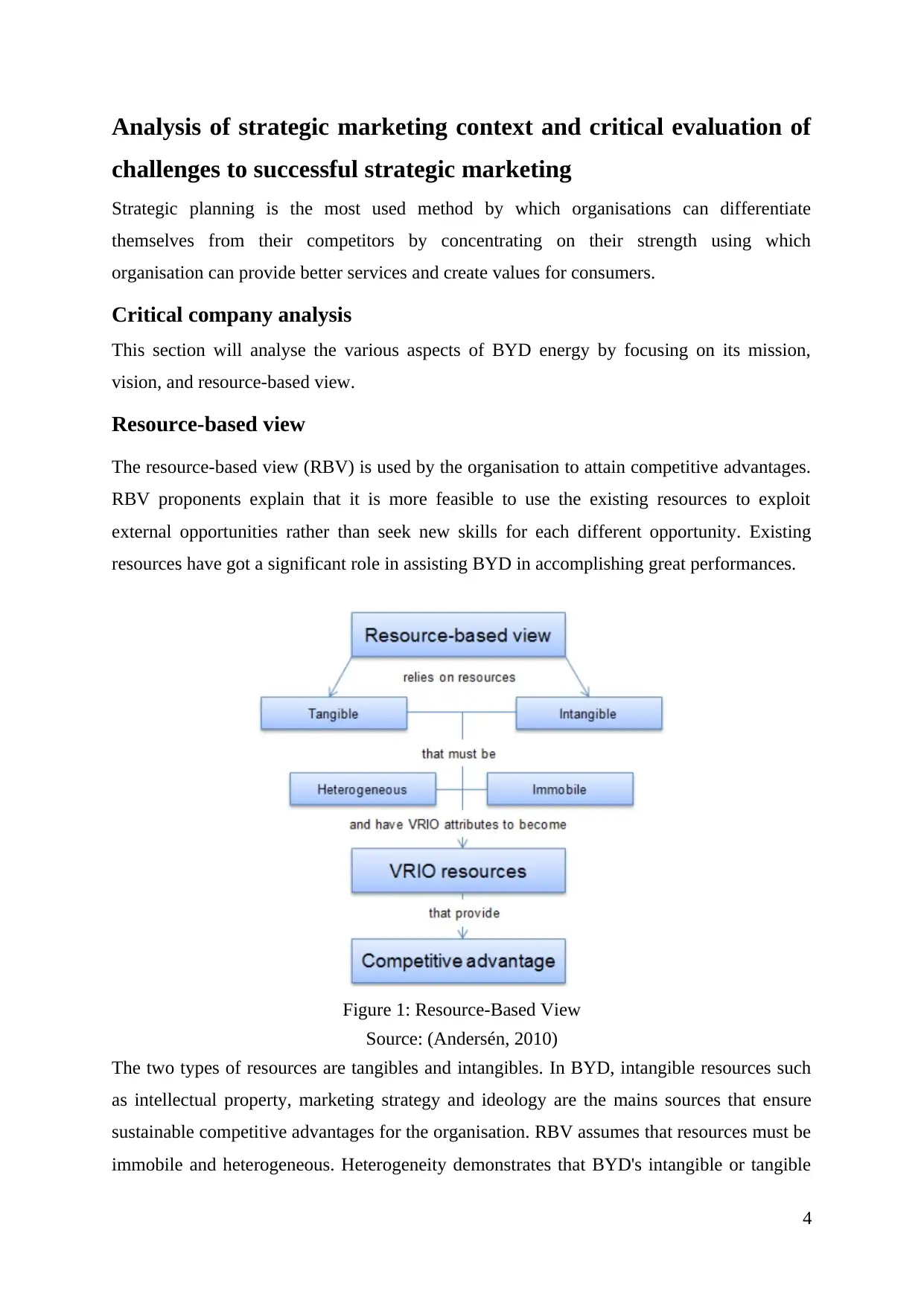
Analysis of strategic marketing context and critical evaluation of
challenges to successful strategic marketing
Strategic planning is the most used method by which organisations can differentiate
themselves from their competitors by concentrating on their strength using which
organisation can provide better services and create values for consumers.
Critical company analysis
This section will analyse the various aspects of BYD energy by focusing on its mission,
vision, and resource-based view.
Resource-based view
The resource-based view (RBV) is used by the organisation to attain competitive advantages.
RBV proponents explain that it is more feasible to use the existing resources to exploit
external opportunities rather than seek new skills for each different opportunity. Existing
resources have got a significant role in assisting BYD in accomplishing great performances.
Figure 1: Resource-Based View
Source: (Andersén, 2010)
The two types of resources are tangibles and intangibles. In BYD, intangible resources such
as intellectual property, marketing strategy and ideology are the mains sources that ensure
sustainable competitive advantages for the organisation. RBV assumes that resources must be
immobile and heterogeneous. Heterogeneity demonstrates that BYD's intangible or tangible
4
challenges to successful strategic marketing
Strategic planning is the most used method by which organisations can differentiate
themselves from their competitors by concentrating on their strength using which
organisation can provide better services and create values for consumers.
Critical company analysis
This section will analyse the various aspects of BYD energy by focusing on its mission,
vision, and resource-based view.
Resource-based view
The resource-based view (RBV) is used by the organisation to attain competitive advantages.
RBV proponents explain that it is more feasible to use the existing resources to exploit
external opportunities rather than seek new skills for each different opportunity. Existing
resources have got a significant role in assisting BYD in accomplishing great performances.
Figure 1: Resource-Based View
Source: (Andersén, 2010)
The two types of resources are tangibles and intangibles. In BYD, intangible resources such
as intellectual property, marketing strategy and ideology are the mains sources that ensure
sustainable competitive advantages for the organisation. RBV assumes that resources must be
immobile and heterogeneous. Heterogeneity demonstrates that BYD's intangible or tangible
4
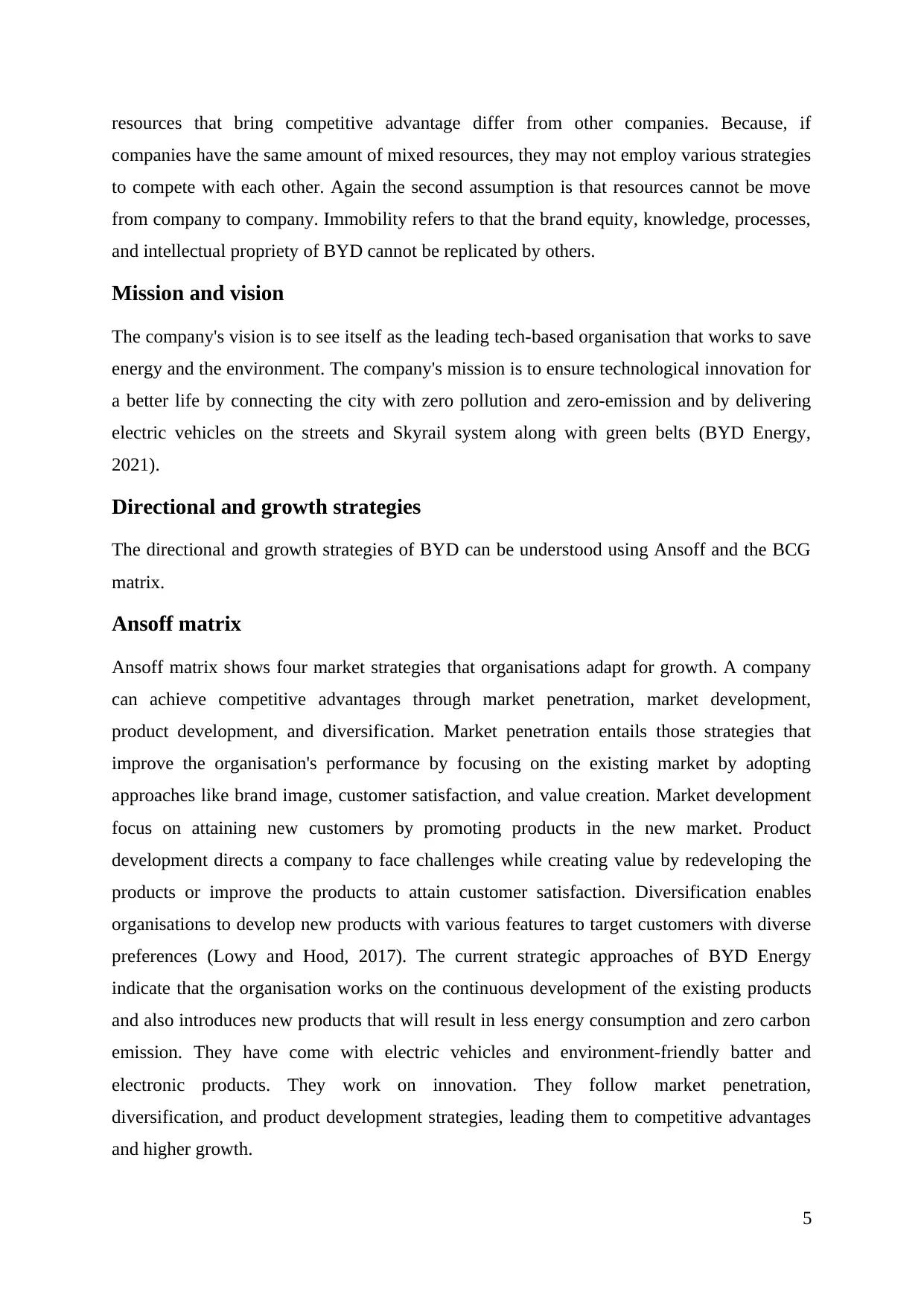
resources that bring competitive advantage differ from other companies. Because, if
companies have the same amount of mixed resources, they may not employ various strategies
to compete with each other. Again the second assumption is that resources cannot be move
from company to company. Immobility refers to that the brand equity, knowledge, processes,
and intellectual propriety of BYD cannot be replicated by others.
Mission and vision
The company's vision is to see itself as the leading tech-based organisation that works to save
energy and the environment. The company's mission is to ensure technological innovation for
a better life by connecting the city with zero pollution and zero-emission and by delivering
electric vehicles on the streets and Skyrail system along with green belts (BYD Energy,
2021).
Directional and growth strategies
The directional and growth strategies of BYD can be understood using Ansoff and the BCG
matrix.
Ansoff matrix
Ansoff matrix shows four market strategies that organisations adapt for growth. A company
can achieve competitive advantages through market penetration, market development,
product development, and diversification. Market penetration entails those strategies that
improve the organisation's performance by focusing on the existing market by adopting
approaches like brand image, customer satisfaction, and value creation. Market development
focus on attaining new customers by promoting products in the new market. Product
development directs a company to face challenges while creating value by redeveloping the
products or improve the products to attain customer satisfaction. Diversification enables
organisations to develop new products with various features to target customers with diverse
preferences (Lowy and Hood, 2017). The current strategic approaches of BYD Energy
indicate that the organisation works on the continuous development of the existing products
and also introduces new products that will result in less energy consumption and zero carbon
emission. They have come with electric vehicles and environment-friendly batter and
electronic products. They work on innovation. They follow market penetration,
diversification, and product development strategies, leading them to competitive advantages
and higher growth.
5
companies have the same amount of mixed resources, they may not employ various strategies
to compete with each other. Again the second assumption is that resources cannot be move
from company to company. Immobility refers to that the brand equity, knowledge, processes,
and intellectual propriety of BYD cannot be replicated by others.
Mission and vision
The company's vision is to see itself as the leading tech-based organisation that works to save
energy and the environment. The company's mission is to ensure technological innovation for
a better life by connecting the city with zero pollution and zero-emission and by delivering
electric vehicles on the streets and Skyrail system along with green belts (BYD Energy,
2021).
Directional and growth strategies
The directional and growth strategies of BYD can be understood using Ansoff and the BCG
matrix.
Ansoff matrix
Ansoff matrix shows four market strategies that organisations adapt for growth. A company
can achieve competitive advantages through market penetration, market development,
product development, and diversification. Market penetration entails those strategies that
improve the organisation's performance by focusing on the existing market by adopting
approaches like brand image, customer satisfaction, and value creation. Market development
focus on attaining new customers by promoting products in the new market. Product
development directs a company to face challenges while creating value by redeveloping the
products or improve the products to attain customer satisfaction. Diversification enables
organisations to develop new products with various features to target customers with diverse
preferences (Lowy and Hood, 2017). The current strategic approaches of BYD Energy
indicate that the organisation works on the continuous development of the existing products
and also introduces new products that will result in less energy consumption and zero carbon
emission. They have come with electric vehicles and environment-friendly batter and
electronic products. They work on innovation. They follow market penetration,
diversification, and product development strategies, leading them to competitive advantages
and higher growth.
5
⊘ This is a preview!⊘
Do you want full access?
Subscribe today to unlock all pages.

Trusted by 1+ million students worldwide
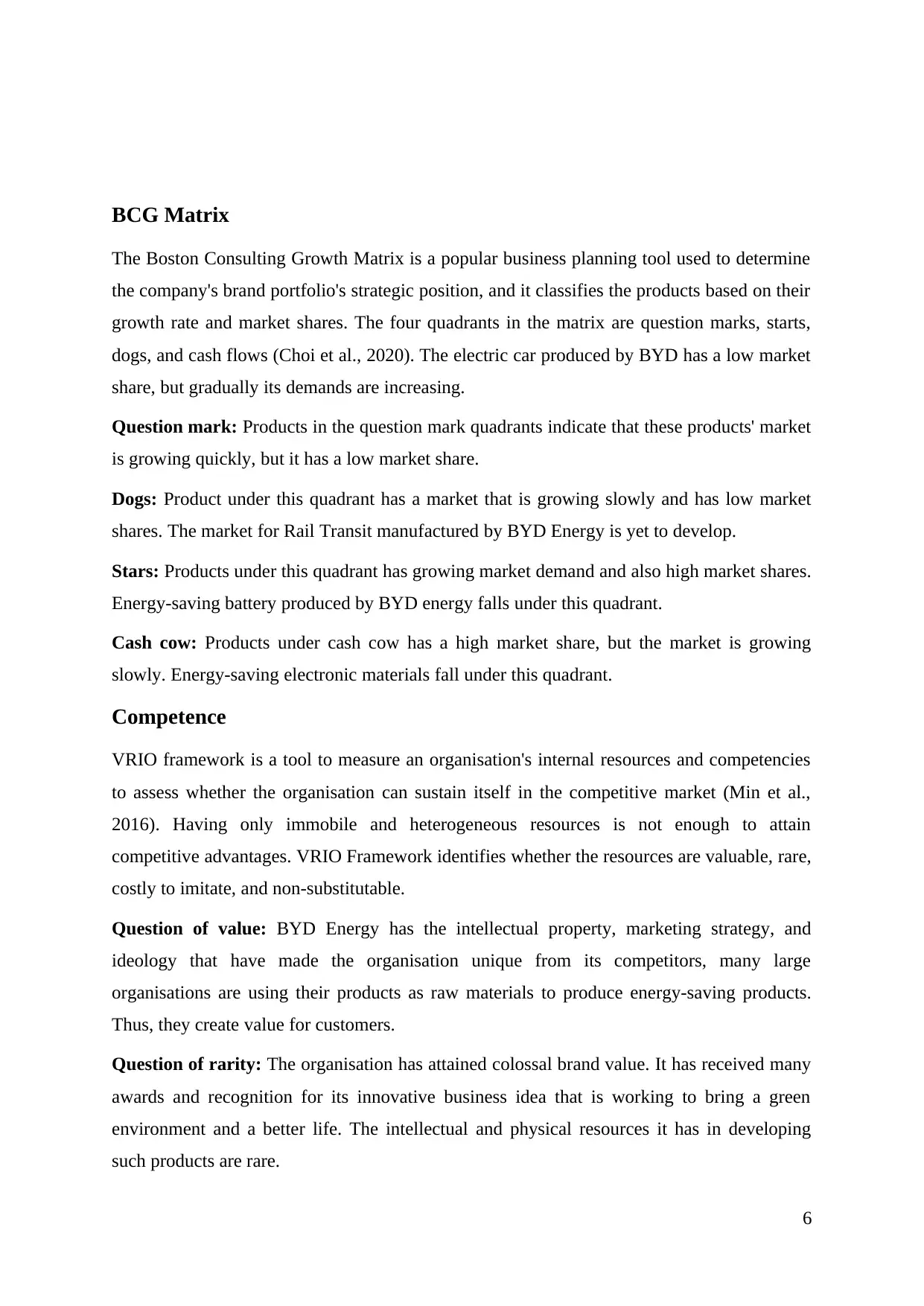
BCG Matrix
The Boston Consulting Growth Matrix is a popular business planning tool used to determine
the company's brand portfolio's strategic position, and it classifies the products based on their
growth rate and market shares. The four quadrants in the matrix are question marks, starts,
dogs, and cash flows (Choi et al., 2020). The electric car produced by BYD has a low market
share, but gradually its demands are increasing.
Question mark: Products in the question mark quadrants indicate that these products' market
is growing quickly, but it has a low market share.
Dogs: Product under this quadrant has a market that is growing slowly and has low market
shares. The market for Rail Transit manufactured by BYD Energy is yet to develop.
Stars: Products under this quadrant has growing market demand and also high market shares.
Energy-saving battery produced by BYD energy falls under this quadrant.
Cash cow: Products under cash cow has a high market share, but the market is growing
slowly. Energy-saving electronic materials fall under this quadrant.
Competence
VRIO framework is a tool to measure an organisation's internal resources and competencies
to assess whether the organisation can sustain itself in the competitive market (Min et al.,
2016). Having only immobile and heterogeneous resources is not enough to attain
competitive advantages. VRIO Framework identifies whether the resources are valuable, rare,
costly to imitate, and non-substitutable.
Question of value: BYD Energy has the intellectual property, marketing strategy, and
ideology that have made the organisation unique from its competitors, many large
organisations are using their products as raw materials to produce energy-saving products.
Thus, they create value for customers.
Question of rarity: The organisation has attained colossal brand value. It has received many
awards and recognition for its innovative business idea that is working to bring a green
environment and a better life. The intellectual and physical resources it has in developing
such products are rare.
6
The Boston Consulting Growth Matrix is a popular business planning tool used to determine
the company's brand portfolio's strategic position, and it classifies the products based on their
growth rate and market shares. The four quadrants in the matrix are question marks, starts,
dogs, and cash flows (Choi et al., 2020). The electric car produced by BYD has a low market
share, but gradually its demands are increasing.
Question mark: Products in the question mark quadrants indicate that these products' market
is growing quickly, but it has a low market share.
Dogs: Product under this quadrant has a market that is growing slowly and has low market
shares. The market for Rail Transit manufactured by BYD Energy is yet to develop.
Stars: Products under this quadrant has growing market demand and also high market shares.
Energy-saving battery produced by BYD energy falls under this quadrant.
Cash cow: Products under cash cow has a high market share, but the market is growing
slowly. Energy-saving electronic materials fall under this quadrant.
Competence
VRIO framework is a tool to measure an organisation's internal resources and competencies
to assess whether the organisation can sustain itself in the competitive market (Min et al.,
2016). Having only immobile and heterogeneous resources is not enough to attain
competitive advantages. VRIO Framework identifies whether the resources are valuable, rare,
costly to imitate, and non-substitutable.
Question of value: BYD Energy has the intellectual property, marketing strategy, and
ideology that have made the organisation unique from its competitors, many large
organisations are using their products as raw materials to produce energy-saving products.
Thus, they create value for customers.
Question of rarity: The organisation has attained colossal brand value. It has received many
awards and recognition for its innovative business idea that is working to bring a green
environment and a better life. The intellectual and physical resources it has in developing
such products are rare.
6
Paraphrase This Document
Need a fresh take? Get an instant paraphrase of this document with our AI Paraphraser
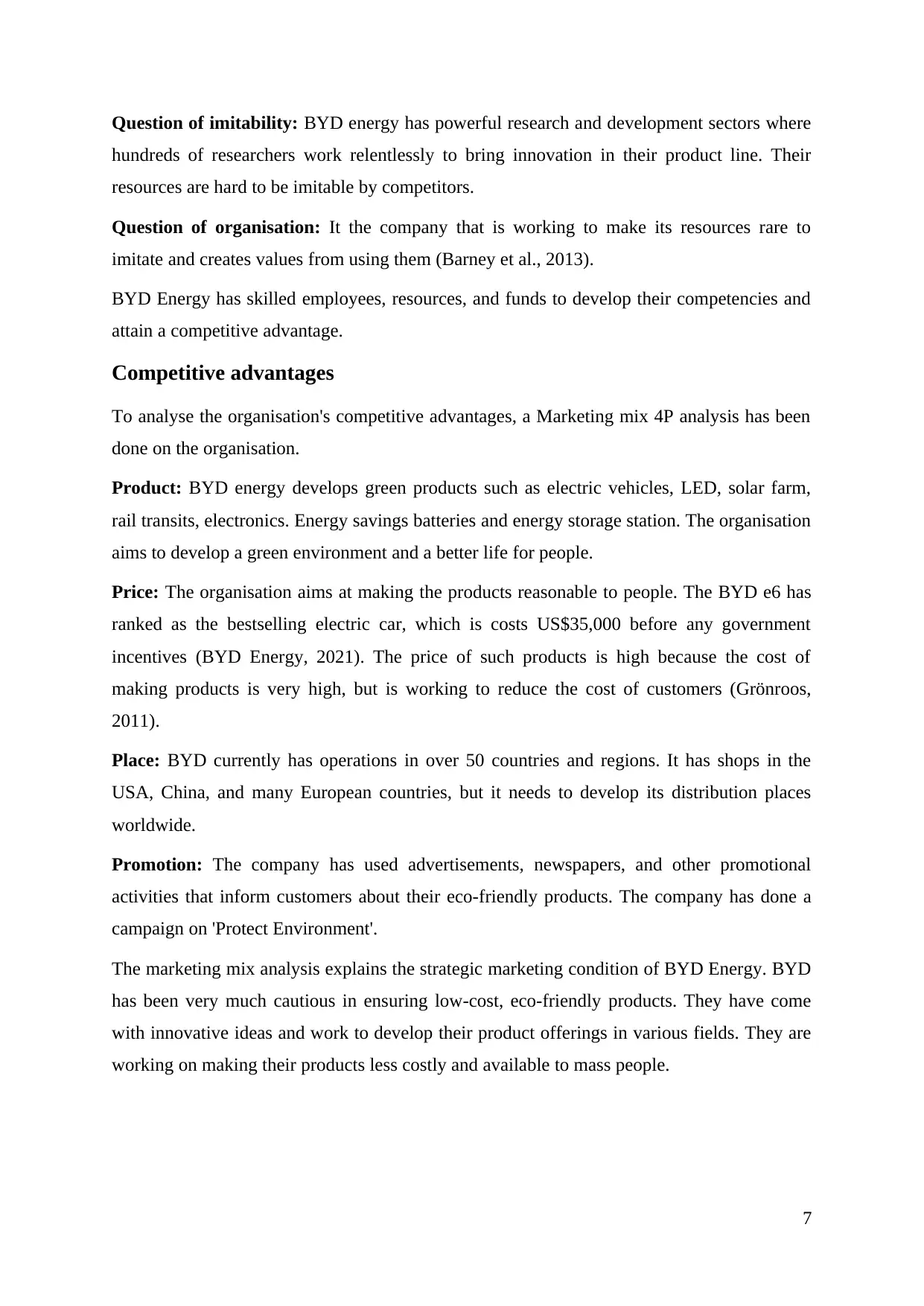
Question of imitability: BYD energy has powerful research and development sectors where
hundreds of researchers work relentlessly to bring innovation in their product line. Their
resources are hard to be imitable by competitors.
Question of organisation: It the company that is working to make its resources rare to
imitate and creates values from using them (Barney et al., 2013).
BYD Energy has skilled employees, resources, and funds to develop their competencies and
attain a competitive advantage.
Competitive advantages
To analyse the organisation's competitive advantages, a Marketing mix 4P analysis has been
done on the organisation.
Product: BYD energy develops green products such as electric vehicles, LED, solar farm,
rail transits, electronics. Energy savings batteries and energy storage station. The organisation
aims to develop a green environment and a better life for people.
Price: The organisation aims at making the products reasonable to people. The BYD e6 has
ranked as the bestselling electric car, which is costs US$35,000 before any government
incentives (BYD Energy, 2021). The price of such products is high because the cost of
making products is very high, but is working to reduce the cost of customers (Grönroos,
2011).
Place: BYD currently has operations in over 50 countries and regions. It has shops in the
USA, China, and many European countries, but it needs to develop its distribution places
worldwide.
Promotion: The company has used advertisements, newspapers, and other promotional
activities that inform customers about their eco-friendly products. The company has done a
campaign on 'Protect Environment'.
The marketing mix analysis explains the strategic marketing condition of BYD Energy. BYD
has been very much cautious in ensuring low-cost, eco-friendly products. They have come
with innovative ideas and work to develop their product offerings in various fields. They are
working on making their products less costly and available to mass people.
7
hundreds of researchers work relentlessly to bring innovation in their product line. Their
resources are hard to be imitable by competitors.
Question of organisation: It the company that is working to make its resources rare to
imitate and creates values from using them (Barney et al., 2013).
BYD Energy has skilled employees, resources, and funds to develop their competencies and
attain a competitive advantage.
Competitive advantages
To analyse the organisation's competitive advantages, a Marketing mix 4P analysis has been
done on the organisation.
Product: BYD energy develops green products such as electric vehicles, LED, solar farm,
rail transits, electronics. Energy savings batteries and energy storage station. The organisation
aims to develop a green environment and a better life for people.
Price: The organisation aims at making the products reasonable to people. The BYD e6 has
ranked as the bestselling electric car, which is costs US$35,000 before any government
incentives (BYD Energy, 2021). The price of such products is high because the cost of
making products is very high, but is working to reduce the cost of customers (Grönroos,
2011).
Place: BYD currently has operations in over 50 countries and regions. It has shops in the
USA, China, and many European countries, but it needs to develop its distribution places
worldwide.
Promotion: The company has used advertisements, newspapers, and other promotional
activities that inform customers about their eco-friendly products. The company has done a
campaign on 'Protect Environment'.
The marketing mix analysis explains the strategic marketing condition of BYD Energy. BYD
has been very much cautious in ensuring low-cost, eco-friendly products. They have come
with innovative ideas and work to develop their product offerings in various fields. They are
working on making their products less costly and available to mass people.
7
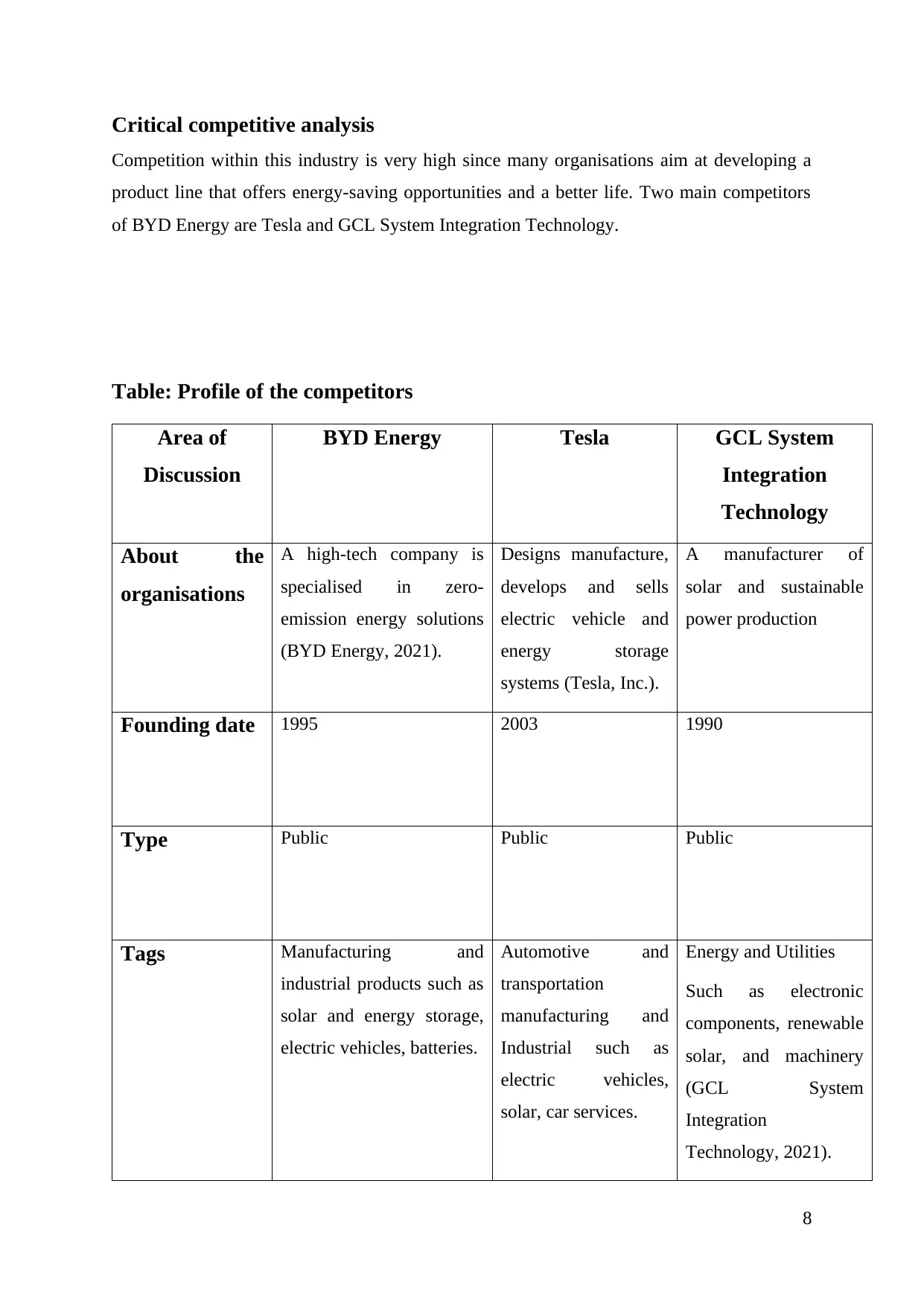
Critical competitive analysis
Competition within this industry is very high since many organisations aim at developing a
product line that offers energy-saving opportunities and a better life. Two main competitors
of BYD Energy are Tesla and GCL System Integration Technology.
Table: Profile of the competitors
Area of
Discussion
BYD Energy Tesla GCL System
Integration
Technology
About the
organisations
A high-tech company is
specialised in zero-
emission energy solutions
(BYD Energy, 2021).
Designs manufacture,
develops and sells
electric vehicle and
energy storage
systems (Tesla, Inc.).
A manufacturer of
solar and sustainable
power production
Founding date 1995 2003 1990
Type Public Public Public
Tags Manufacturing and
industrial products such as
solar and energy storage,
electric vehicles, batteries.
Automotive and
transportation
manufacturing and
Industrial such as
electric vehicles,
solar, car services.
Energy and Utilities
Such as electronic
components, renewable
solar, and machinery
(GCL System
Integration
Technology, 2021).
8
Competition within this industry is very high since many organisations aim at developing a
product line that offers energy-saving opportunities and a better life. Two main competitors
of BYD Energy are Tesla and GCL System Integration Technology.
Table: Profile of the competitors
Area of
Discussion
BYD Energy Tesla GCL System
Integration
Technology
About the
organisations
A high-tech company is
specialised in zero-
emission energy solutions
(BYD Energy, 2021).
Designs manufacture,
develops and sells
electric vehicle and
energy storage
systems (Tesla, Inc.).
A manufacturer of
solar and sustainable
power production
Founding date 1995 2003 1990
Type Public Public Public
Tags Manufacturing and
industrial products such as
solar and energy storage,
electric vehicles, batteries.
Automotive and
transportation
manufacturing and
Industrial such as
electric vehicles,
solar, car services.
Energy and Utilities
Such as electronic
components, renewable
solar, and machinery
(GCL System
Integration
Technology, 2021).
8
⊘ This is a preview!⊘
Do you want full access?
Subscribe today to unlock all pages.

Trusted by 1+ million students worldwide

Logo
Strategies, competencies, and competitive positioning of the organisation
The strategies followed by all three organisations are shown in the table
Table 2: Strategies, competencies, and competitive positioning of the organisation
Area of
Discussion BYD Energy Tesla
GCL System
Integration
Technology
Strategy
7+4 Full Market EV
Strategy. Here 7
represents seven
traditional transportation
fields, and 4 represents
four special fields such as
warehouse, mining port,
and airport.
Zero energy emission.
Differentiation
strategy
Environment-
friendly product
Sustainable energy
Integrated
value chain
operation
Expertise in
providing solar
package
solutions.
Having a large
solar plant.
Competencies
Specialist in
manufacturing electric
vehicles, energy, zero
energy emission batteries,
and vehicle
manufacturing.
Strong research and
development wings.
Innovative
manufacturing
techniques
Battery pack
technology
Safety design and
distribution
An international
energy
conglomerate
specialising in
sustainable and
clean energy
systems.
9
Strategies, competencies, and competitive positioning of the organisation
The strategies followed by all three organisations are shown in the table
Table 2: Strategies, competencies, and competitive positioning of the organisation
Area of
Discussion BYD Energy Tesla
GCL System
Integration
Technology
Strategy
7+4 Full Market EV
Strategy. Here 7
represents seven
traditional transportation
fields, and 4 represents
four special fields such as
warehouse, mining port,
and airport.
Zero energy emission.
Differentiation
strategy
Environment-
friendly product
Sustainable energy
Integrated
value chain
operation
Expertise in
providing solar
package
solutions.
Having a large
solar plant.
Competencies
Specialist in
manufacturing electric
vehicles, energy, zero
energy emission batteries,
and vehicle
manufacturing.
Strong research and
development wings.
Innovative
manufacturing
techniques
Battery pack
technology
Safety design and
distribution
An international
energy
conglomerate
specialising in
sustainable and
clean energy
systems.
9
Paraphrase This Document
Need a fresh take? Get an instant paraphrase of this document with our AI Paraphraser

Positioning in
the market New energy solution pioneer High-end
manufacturer and
dealer of luxury eco-
friendly car and other
electric products.
Integrated clean
energy solution
provider
BYD energy has 229,154 employees, which is more than that of Tesla and GCL. The
company has employed huge people, and it has secured a strong competitive position in the
market (Dombrowski, Krenkel, and Wullbrandt, 2018). BYD energy has gained significant
value for its ideology and unique market positioning. Moreover, the organisation serves a
large number of consumer segments. Government and large institutions are helping BYD
Energy is expanding its operations in many countries.
Customer analysis
Customers are the essence of all businesses. The satisfaction of customers is the primary
priority of every organisation. When serving customers, BYD Energy always focuses on
providing better service. They aim at providing energy savings to make the ecological
balanced.
Segmentation
The STP ( Segmentation, Targeting and Positioning) analysis identifies the customers and
target of BYD Energy. The company has segmented its market based on geographic,
behavioural, and psychographic base. The organisation is currently providing its services to
Asia, Europe, and the U.S. It is working providing low-cost products and provides raw purses
to large companies, in order to cut costs so that people can afford energy-saving vehicles at a
reasonable price. The company has targeted products based on their income level and
psychology to use green products. People who want to contribute to the energy-saving
campaign tend to use less energy consumption products. People now tend to purchase these
products for which the consumer base for BYD Energy is growing up.
The users of BYD Energy are large institutions that purchase bulks of products. The use of
electronics products is gradually increasing because manufacturer companies drive toward
eco-friendly products (Dehghan, 2018) and because people become aware of using ecological
products. So, BYD Energy has focused on institutional buyers who are operating in many
countries.
10
the market New energy solution pioneer High-end
manufacturer and
dealer of luxury eco-
friendly car and other
electric products.
Integrated clean
energy solution
provider
BYD energy has 229,154 employees, which is more than that of Tesla and GCL. The
company has employed huge people, and it has secured a strong competitive position in the
market (Dombrowski, Krenkel, and Wullbrandt, 2018). BYD energy has gained significant
value for its ideology and unique market positioning. Moreover, the organisation serves a
large number of consumer segments. Government and large institutions are helping BYD
Energy is expanding its operations in many countries.
Customer analysis
Customers are the essence of all businesses. The satisfaction of customers is the primary
priority of every organisation. When serving customers, BYD Energy always focuses on
providing better service. They aim at providing energy savings to make the ecological
balanced.
Segmentation
The STP ( Segmentation, Targeting and Positioning) analysis identifies the customers and
target of BYD Energy. The company has segmented its market based on geographic,
behavioural, and psychographic base. The organisation is currently providing its services to
Asia, Europe, and the U.S. It is working providing low-cost products and provides raw purses
to large companies, in order to cut costs so that people can afford energy-saving vehicles at a
reasonable price. The company has targeted products based on their income level and
psychology to use green products. People who want to contribute to the energy-saving
campaign tend to use less energy consumption products. People now tend to purchase these
products for which the consumer base for BYD Energy is growing up.
The users of BYD Energy are large institutions that purchase bulks of products. The use of
electronics products is gradually increasing because manufacturer companies drive toward
eco-friendly products (Dehghan, 2018) and because people become aware of using ecological
products. So, BYD Energy has focused on institutional buyers who are operating in many
countries.
10

Customer behaviour and trend analysis
Customer behaviour analysis works to identify the reasons behind the customer attitude. It
identifies how the market makes a purchasing decision with regards to the product, service,
and organisation. The various marketing campaigns are done to identify the trend of
customers' purchasing behaviour (Groh, 2016). The feelings of using electric vehicles come
from excess environmental pollution, and the trend for using eco-friendly products is
increasing among customers. The major customers of BYD Energy are government and other
large transportation companies. It requires more time to reach the general people. BYD
Energy supplies batteries and other electric vehicles. The number of users' increase depends
on travel behaviour, cost and benefit of using cars. It has been found from the survey that the
cost of energy in battery electric vehicles (BEV) is very low compared to that of commercial
vehicles (CV). The user's experience depends on other various factors like mileage coverage
of vehicles.
Figure 2: Comparison between CV's and BEVs in terms of energy cost
Source: (Bojić et al., 2019)
The usage of energy-saving products helps the environment remain healthy. People are now
aware of maintaining a healthy environment as the various environmental problems have
become acute in recent years. The carbon emission from vehicles is one of the hazardous for
the earth. BYD energy has come with the purpose to make the life of people better. They
have come with many promotional activities to inform people about the importance of using
energy-saving products. The gradual trend of the consumer in using such products is
increasing over time.
11
Customer behaviour analysis works to identify the reasons behind the customer attitude. It
identifies how the market makes a purchasing decision with regards to the product, service,
and organisation. The various marketing campaigns are done to identify the trend of
customers' purchasing behaviour (Groh, 2016). The feelings of using electric vehicles come
from excess environmental pollution, and the trend for using eco-friendly products is
increasing among customers. The major customers of BYD Energy are government and other
large transportation companies. It requires more time to reach the general people. BYD
Energy supplies batteries and other electric vehicles. The number of users' increase depends
on travel behaviour, cost and benefit of using cars. It has been found from the survey that the
cost of energy in battery electric vehicles (BEV) is very low compared to that of commercial
vehicles (CV). The user's experience depends on other various factors like mileage coverage
of vehicles.
Figure 2: Comparison between CV's and BEVs in terms of energy cost
Source: (Bojić et al., 2019)
The usage of energy-saving products helps the environment remain healthy. People are now
aware of maintaining a healthy environment as the various environmental problems have
become acute in recent years. The carbon emission from vehicles is one of the hazardous for
the earth. BYD energy has come with the purpose to make the life of people better. They
have come with many promotional activities to inform people about the importance of using
energy-saving products. The gradual trend of the consumer in using such products is
increasing over time.
11
⊘ This is a preview!⊘
Do you want full access?
Subscribe today to unlock all pages.

Trusted by 1+ million students worldwide
1 out of 20
Related Documents
Your All-in-One AI-Powered Toolkit for Academic Success.
+13062052269
info@desklib.com
Available 24*7 on WhatsApp / Email
![[object Object]](/_next/static/media/star-bottom.7253800d.svg)
Unlock your academic potential
Copyright © 2020–2025 A2Z Services. All Rights Reserved. Developed and managed by ZUCOL.





